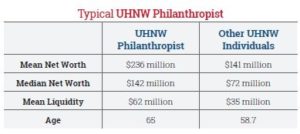by Barlow Mann
There is a famous saying attributed to an exchange between F. Scott Fitzgerald and Ernest Hemingway: Fitzgerald supposedly remarked, “(The rich) are different from you and me.” Hemingway’s response: “Yes, they have more money.”*
What do we really know about very wealthy donors? The Wealth-X and Arton Capital Philanthropy Report 2015 provides some useful insights into charitable giving by ultra high net worth (UHNW) donors. The global study is a record of more than 211,000 UHNW individuals whose net assets total at least $30 million.
The total sum of gifts by these philanthropists throughout the world in 2014 was $112 billion, which is up 6.4 percent from 2013 and reached an all-time high with growth of more than 25 percent above the first study’s total in 2004. The total given represents an average of just more than $530,000 per individual.
The typical UHNW donor
The comprehensive report highlights giving trends based on various demographics, including gender, age, wealth tier, industry represented, relationship status and whether the wealth was inherited or self-made, among other factors. The typical UHNW philanthropist is a self-made male billionaire who made his fortune in the finance industry. He is single, over the age of 50. He can be expected to give $29 million during his lifetime and is almost twice as wealthy and approximately six years older than UHNW individuals who are not philanthropists.
See the following summary of UHNW wealth and age:
Perhaps surprisingly to some, the study also indicates there are more UHNW philanthropists 80 years of age and older than all of those under the age of 50. Almost two-thirds are over the age of 60.
The study also finds that donors who were single or widowed were substantially more generous, both in total amounts and percentage of wealth, than those who were divorced or married.
The ultra wealthy in the United States
Even though the report is global in nature, the findings highlight some important facts (including interesting differences) about UHNW philanthropists in the United States. In fact, the study revealed American self-made billionaires gave the most, some $180 million per person over a lifetime—more than six times the typical UHNW donor. Still, the United States trails behind India, the United Kingdom and Hong Kong in total amount given. On the other hand, the U.S. is second, following only the U.K., when comparing giving as a percentage of net worth.
The men among American UHNW donors gave a larger sum ($29 million vs $27 million) than women. However, America’s ultra-wealthy women who gave from their inherited assets led the way based on the percentage of their wealth (nearly 19 percent).
Another interesting fact distinguishing American philanthropists from the rest of the world is in the types of organizations they primarily support. Globally, education and healthcare nonprofits received the most gifts. By contrast, 32 percent of gifts made by UHNW Americans were made to religious organizations followed by education at 15 percent, human services and grant-making foundations at 12 percent and finally health at just 8 percent. By contrast, religion was the least supported category globally.
For more information and to view the entire report, click here. ■
For more information on how you can better segment your donor file for planned or major gift solicitation efforts, click here.
* The exchange was not a direct conversation. Rather, Hemingway addressed a quote from Fitzgerald’s short story “The Rich Boy” in his own short story “The Snows of Kilimanjaro.” Still, it is widely recognized as an exchange between the two writers.



